

|
| DEUTSCHLAND | GERMANY |
| Bundesland: Brandenburg | |
| Stadt: Potsdam |
Potsdam (Poztupimi, under the oaks) was first mentioned in a document of AD 993. Soon a castle near the Slavic village
protected the place on the river. After a large fire which had destroyed large parts of the town in 1536, Potsdam was rebuilt but destroyed again during the Thirty Years' War (1618–1648).
In 1660 only 50 tax payers had remained. In 1640 Elector Friedrich Wilhelm of Brandenburg made Potsdam his second residence after Berlin.
With the 'Edikt von Potsdam' (1685) Friedrich Wilhelm allowed the Huguenots to enter and settle in his country. Under his grandson, Friedrich Wilhelm I, King in Prussia,
Potsdam was transformed into a garrison town. King Friedrich II ('the Great') transformed the town into an elegant residence city.
The end of the German Empire in 1918 was also the end of Potsdam's role as Imperial residence. World War II caused severe admages in the town.
The Potsdam Conference and the Potsdam Agreement of 1945, signed by Truman, Churchill and Stalin, determined Germany's and Europe's post-war history.
In 1952 Potsdam lost its role as capital of the state of Brandenburg but it regained this status in 1989. The palaces and parks in Potsdam and Berlin
were listed as a World Cultural Heritage by the UNESCO in 1990 (see also list of other UNESCO heritage sites).
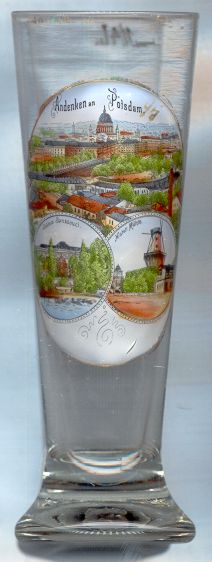
The dome of the  Nikolaikirche (church of St. Nicholas) [left, no. 1170: top] is still the
dominant feature of the historic old town of Potsdam. The construction of the church, designed by the famous architect Karl Friedrich Schinkel, began in 1828. After the death of Schinkel it was continued by his
followers Ludwig Persius and August Stüler. It was completed in 1850. The Nikolaikirche is one of Germany's most important buildings in Classicist style.
Nikolaikirche (church of St. Nicholas) [left, no. 1170: top] is still the
dominant feature of the historic old town of Potsdam. The construction of the church, designed by the famous architect Karl Friedrich Schinkel, began in 1828. After the death of Schinkel it was continued by his
followers Ludwig Persius and August Stüler. It was completed in 1850. The Nikolaikirche is one of Germany's most important buildings in Classicist style.
 Schloss Sanssouci [left, no. 1170: bottom left] was built in 1745 as a summer residence for King Friedrich II
by Georg Wenzeslas von Knobelsdorff in Rococo style. It is certainly the most famous historic building of Potsdam. It was the wish of Friedrich II to be buried
next to Sansouci palace. However, after his death in 1786 his body was laid to rest in the Garnisonkirche (see below). Only in 1991 the coffin was
brought back to Potsdam and was interred next to Sanssouci near the graves of his 11 beloved dogs.
Schloss Sanssouci [left, no. 1170: bottom left] was built in 1745 as a summer residence for King Friedrich II
by Georg Wenzeslas von Knobelsdorff in Rococo style. It is certainly the most famous historic building of Potsdam. It was the wish of Friedrich II to be buried
next to Sansouci palace. However, after his death in 1786 his body was laid to rest in the Garnisonkirche (see below). Only in 1991 the coffin was
brought back to Potsdam and was interred next to Sanssouci near the graves of his 11 beloved dogs.
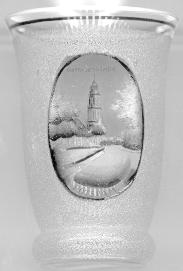
The  Garnisonkirche (Garrison Church) [right, no. 744] was built in 1734–1735 by the architect Philipp Gerlach.
King Friedrich Wilhelm I of Prussia was buried here in 1740, followed by his son, King Friedrich II in 1786. King Friedrich Wilhelm III and his wife, Queen Luise,
met Czar Alexander I of Russia here in 1805. Napoleon visited the Royal tombs of the church in 1806. On 21 March 1933 (the 'day of Potsdam' as it was called later),
the Nazis opened the newly-elected Reichstag here. In 1943, the coffins of Friedrich Wilhelm I and Friedrich II
were moved to a bunker in Potsdam-Eiche from where they were moved further to the salt mine of Bernterode near
Eichsfeld in Thuringia. After the war, the coffins were buried in the church of St. Elisabeth in
Marburg were they remained until 1952 when they were brought to to the chapel of
Hohenzollern castle near Hechingen. The Garnisonkirche was heavily damaged by an air raid in 1945. In 1968 the
Communist city administration decided to pull down the church. At present there are plans
to rebuild this important monument of German history. In 1991 the coffins of Friedrich Wilhelm I and Friedrich II
were returned to Potsdam. Friedrich II is now buried, according to his own wish, next to his beloved dogs in a burial
vault beside Sanssouci palace, Friedrich Wilhelm I was buried in the Mausoleum beside the Friedenskirche (Church of Peace) in Sanssouci Park.
Garnisonkirche (Garrison Church) [right, no. 744] was built in 1734–1735 by the architect Philipp Gerlach.
King Friedrich Wilhelm I of Prussia was buried here in 1740, followed by his son, King Friedrich II in 1786. King Friedrich Wilhelm III and his wife, Queen Luise,
met Czar Alexander I of Russia here in 1805. Napoleon visited the Royal tombs of the church in 1806. On 21 March 1933 (the 'day of Potsdam' as it was called later),
the Nazis opened the newly-elected Reichstag here. In 1943, the coffins of Friedrich Wilhelm I and Friedrich II
were moved to a bunker in Potsdam-Eiche from where they were moved further to the salt mine of Bernterode near
Eichsfeld in Thuringia. After the war, the coffins were buried in the church of St. Elisabeth in
Marburg were they remained until 1952 when they were brought to to the chapel of
Hohenzollern castle near Hechingen. The Garnisonkirche was heavily damaged by an air raid in 1945. In 1968 the
Communist city administration decided to pull down the church. At present there are plans
to rebuild this important monument of German history. In 1991 the coffins of Friedrich Wilhelm I and Friedrich II
were returned to Potsdam. Friedrich II is now buried, according to his own wish, next to his beloved dogs in a burial
vault beside Sanssouci palace, Friedrich Wilhelm I was buried in the Mausoleum beside the Friedenskirche (Church of Peace) in Sanssouci Park.
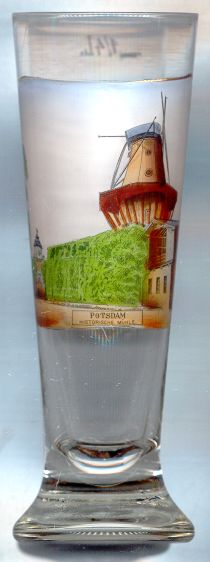
The  historic windmill [left, no. 1171] was erected in 1787–1790.
It replaced the first windmill that had been built in this place in 1739.
The mill operated until the late 1860s, after that it was opened to the public but was finally destoyed by fire in 1945. A reconstruction of the historic mill
was completed in 1993, in time for the 1000th anniversary of Potsdam.
historic windmill [left, no. 1171] was erected in 1787–1790.
It replaced the first windmill that had been built in this place in 1739.
The mill operated until the late 1860s, after that it was opened to the public but was finally destoyed by fire in 1945. A reconstruction of the historic mill
was completed in 1993, in time for the 1000th anniversary of Potsdam.

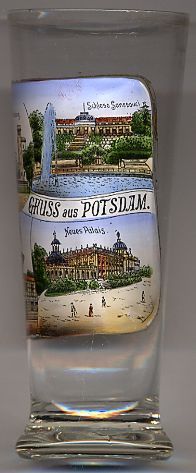 The pictures on glass no. 2596 [near left and right] show:
The pictures on glass no. 2596 [near left and right] show:
 Schloss Babelsberg [top left]
was established to 1833 as summer seat for the later emperor Wilhelm I in the delightful hill landscape at the Havel in neogothic style after plans
of Karl Friedrich Schinkel. Schinkel oriented himself at English models, imitated the English Tudor style.
Schloss Babelsberg [top left]
was established to 1833 as summer seat for the later emperor Wilhelm I in the delightful hill landscape at the Havel in neogothic style after plans
of Karl Friedrich Schinkel. Schinkel oriented himself at English models, imitated the English Tudor style.
 Historic windmill [bottom left] (see above).
Historic windmill [bottom left] (see above).
 Schloss Sanssouci [top right] (see above).
Schloss Sanssouci [top right] (see above).
The  Neues Palais ('New Palace') [bottom right]
is situated on the western side of the Sanssouci royal park. The building was begun in 1763, after the end of the Seven Years' War, under Friedrich II ('the Great')
and was completed in 1769. It is considered to be the last great Prussian baroque palace. The architect was Carl von Gontard.
Neues Palais ('New Palace') [bottom right]
is situated on the western side of the Sanssouci royal park. The building was begun in 1763, after the end of the Seven Years' War, under Friedrich II ('the Great')
and was completed in 1769. It is considered to be the last great Prussian baroque palace. The architect was Carl von Gontard.
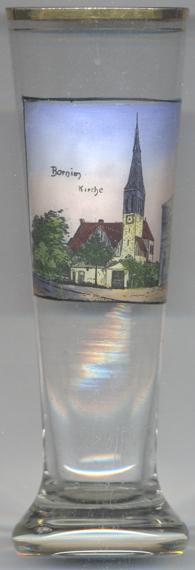
Bornim was first mentioned in 1335. In 1663 it became part of the domains of Electors Friedrich Wilhelm of Brandenburg who in 1664–1677 had founded a park and summer residence. the residence was demolished in 1756. In 1935 Bornim was incorporated into the municipality of Potsdam.
The  village church [left, no. 3219] was built in 1902 by the
architect Ludwig von Tiedemann.
village church [left, no. 3219] was built in 1902 by the
architect Ludwig von Tiedemann.
[https://de.wikipedia.org/wiki/Bornim]
![[scale]](lineal.jpg)